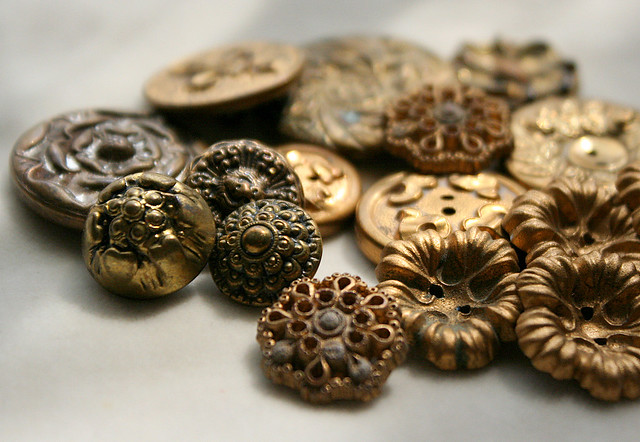The secret lives of buttons
“Yes, it’s true, the humble household button has a past”
The humble button
Have you ever looked at a garment in a shop and thought there was something special about it but you couldn’t put your finger on what it was or alternatively have you ever bought a garment just because the buttons were gorgeous (something I have been known to do on occasion). If you google ‘buttons’ you will find hundreds, thousands of sites dedicated to buttons, the history of buttons, vintage button collections etc. There is no denying that the humble button holds our fascination and has done so for centuries. Yes, it’s true, the humble household button has a past (insert music stab here)... In fact, throughout the centuries, the simple button not only shaped our style choices, literally, but at times they also defined our social standing. Buttons freed us from shapeless, oversized garments and encouraged, even enticed us to try styles that celebrated shape and form. Often times buttons demonstrate the wealth of the wearer and in time would become a lucrative business option for many. Is it just me or does the humble button suddenly seem strangely seductive?
These beautiful creatures are one of my favourite acquisitions
It’s interesting to think that in most archaeological digs throughout the world one of the common items often found are... your guessed it, buttons! The earliest known button writes Ian McNeil in An Encyclopedia of the History of Technology, (Routledge Companion Encyclopedias) "was originally used more as an ornament than as a fastening, the earliest known being found at Mohenjo-Daro in the Indus Valley [now Pakistan]. It is made of a curved shell and about 5000 years old." Early buttons were generally sewn directly on to the garment like a brooch and therefore rarely appeared in straight rows but here and there to embellish a garment.
It is during the Middle Ages that the button gained greater prominence as they became a sign of wealth as well as a way to style and fit garments. “About the middle of the eleventh century,” writes Carl Köhler in A History of Costume, “clothes began to be made so close-fitting that they followed the lines of the body from shoulders to hips like a glove.” This preference for a more close-fitted style could only be achieved with the use of our humble little button (or lacing of course). However this was only the case for men’s clothing, ladies, unfortunately, we were forced to continue to sew or lace our clothing on (and cut it off) each day up until the late victorian era. The reason being that the female form was something that was meant to be kept under lock and key, secret and unaccessible and the button represented a sense of ‘easy access’! Mind you I guess the morality police forgot, or chose to ignore, that throughout these era's women wore crotchless pantalets... hmmm
Believe it or not, the simple button gained such prominence that the first button-makers guild was formed in France in 1250. Still regarded basically as a form of jewellery, buttons were so prized that, according to Franco Jacassi (reputedly the world’s biggest button-collector) laws were enacted that prohibited commoners from sewing more than 50 silver buttons on their jackets mainly to prevent them from giving an impression of the unmerited aristocracy. Jacassi goes on to say that it was a time when you could pay off a debt by plucking a precious button from your suit. Also even today in Italy rooms in which powerful leaders meet are described as stanze dei bottoni, “rooms of the buttons.”
Some more interesting anecdotes from Franco Jacassi, Frederick the Great allegedly forced his troops to sew buttons on their sleeves so they wouldn't be able to wipe their noses with them. Also portrait buttons painted with the faces of your loved ones were very popular, especially with soldiers who would sew them on the inside of their uniforms to keep their lover next to their heart.
Portrait buttons were one thing however as time went on more interesting or even sinister designs became popular, for example, the interesting kind... “habitat” buttons, built to contain keepsakes like dried flowers, hair cuttings or tiny insects under glass. The more sinister kind... hollowed-out smuggler buttons allowing thieves to transport jewels and other illegal items.
I have to admit…
I certainly have!
If you have ever wondered 'why do men’s and women's shirts button up on different sides?' this seems to be the most interesting answer I have found and the one that makes the most sense, in previous eras complicated button closures often meant people needed help to get dressed and so it was around this time (mid-Victorian I think) when buttons swapped sides. Men started to dress themselves more and so their buttons faced right for their convenience. Women with ladies’ maids wore their buttons on the left, to make it easier for the maids to manoeuvre while facing them.





